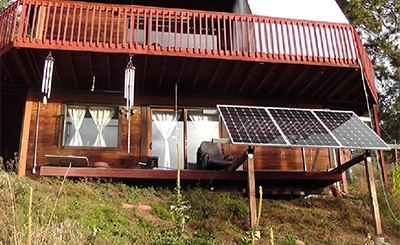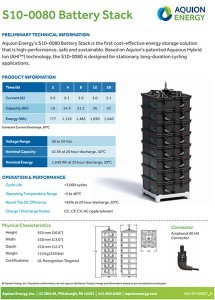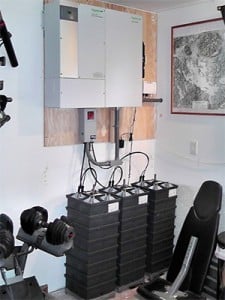
Ben’s off-grid solar array used to power his office.
I admit, I already run my home with the help of a nice 8.8kW grid tie solar electric system. But in the event the power goes out, so does my big, bad solar array. Having an all electric house makes for quite a load to run off of batteries when the grid goes down. Not trusting my family to conserve power while the whole house is being backed up with batteries, I decided the only thing I really needed to run off batteries is my home office.
One may ask, what about the other loads in your house such as hot water, the refrigerator, the electric stove, yada yada? All I have to say is man existed before electricity, but current man, who works from home, needs the internet, computer and phone to survive. So I decided to take the leap to run my home office as an off grid system instead of making it grid tie with battery backup. The reason for keeping the office completely off grid now is that I also want to know what it’s like to live with a system that doesn’t have grid power or generator backup to rescue the batteries. Plus, many of my installer customers that I sell to, work with the whole range, from grid tie, grid tie with battery backup, to fully off grid, and it’s good for me to have hands-on experience with the products they work with everyday.
Sizing The System
In terms of sizing, it was pretty simple since my office loads max out at around 230 watts. Multiply 230 watts x 12 hours (some work days are longer than others) to get 2760 watt hours needed per day for the busiest day. Taking 2760 watt hours and dividing by 5 hours of solar insolation (I live at 8,000ft in the sunny Rockies so more sun and intensity than most places) gives me 552 watts of PV needed. Multiply 552 watts x 1.25% for off grid inefficiencies and I get 690 watts needed. Luckily I scored a good deal on 3 Solarworld 250’s the year before so those ended up being sized perfectly for my home system at 750 watts total. For racking, I used the IronRidge XRS system with an adjustable tilt mount to locate the panels close to my office and battery/inverter system, as shown above. IronRidge Adjustable Tilt Leg, 56″ (58-94″) Ironridge XR-1000 Rail, 14 Foot Section, Mill
 Batteries
Batteries
The other parts of the system slowly came together, as I was able to afford them over time, such as the batteries, inverter and charge controller. For batteries, I ended up using the Aquion Energy S10 stacks since this company has been on my radar for a while and I was excited to finally use their product when it became available. The major benefits of these batteries, to me, was three fold.
- They can be discharged 100% without being harmed versus most other deep cycle battery technologies out there that really don’t like going below 50% Depth of Discharge.
- They are non toxic. I believe in walking the talk and treating the environment as friendly as possible, as well as the health of my family. They use their “patented Aqueous Hybrid Ion (AHI™) battery technology that provides high performance, safe, sustainable, and cost-effective energy storage for long-duration stationary applications. Aqueous Hybrid Ion (AHI™) chemistry, a unique saltwater electrolyte battery technology.”
- Their ability to stand at a partial state of charge. I don’t have to worry if my system gets drawn down and I’m unable to get it fully charged during the day. This is good since I have no other energy input other than my 3 solar panels. Even though I live in CO, we can get a few days without sun once in a while.
See the higher capacity Aquion Energy S30 Batteries – now available at altE!
Sizing the Batteries
Sizing for the 3 S10 stacks is as follows. Each unit will discharge more or less amp hours depending upon the rate of discharge. For the 12 hour rate, each S10 stack (mine were set at 48V each) can discharge 36 amp hours. 36Ah x 3 stacks x 48VDC = 5184 watt hours total storage, so I roughly have about 2 days of backup currently. So far, I’ve run the battery down to 32%, and let me tell you, it’s a weird feeling to go below 50% Depth of Discharge and not fear the death of your batteries.
Also, as can be seen in the image below, the Aquion S10 stacks don’t use regular 2/0 or 4/0 battery cable, but standard H4 connectors just like Solar Panels. This is because the batteries are limited to 15 amps of discharge each. So in order to parallel, you’ll need to use a combiner box and will also be limited on your output by the quantity of S10 stacks you purchase. The quantity of 3 was fine for my office since 15 amps x 3 x 48VDC = 2160 watts and my loads are only around 250 watts or less. In reality the battery doesn’t like to discharge more than 8 amps for regular use, so that would in essence be 1152 watts, but still fine considering the loads.
 Inverter
Inverter
For the Inverter, I selected the Xantrex XW4548 by Schneider Electric. I’ve been selling this unit and it’s big brother, the XW6048, for years and finally got to be able to use one myself – what a great unit it is. It pairs so well with their load enclosure, the XW Power Distribution Panel and their monitoring system the ComBox. For my current situation it’s a bit big, but after a year of keeping my office off grid, I plan on upgrading my battery bank and servicing more loads/circuits in my home (kitchen for running fridge and freezer, and well pump since the inverter can also power 240VAC loads as well as 120VAC). I also plan on grid tying my array so any overproduction can go toward my growing kWh overproduction bank.
Charge Controller
For the charge controller, I’m currently using the Midnite Classic 150 along with the MidNite Whiz Bang Jr for battery bank metering. I like how the shunt-based Whiz Bang Jr shows the battery state of charge on the same status screen as the charge controllers solar output. I will say that having to upload the firmware of the Classic 150 was a pain, since the Whizbang wouldn’t work without the latest version, but after having the ComBox and seeing how easy it is to view my system, I am going to switch the the Xantrex XW MPPT 60A Charge Controller instead. This way I can also view my solar production on the same ComBox platform. Currently the ComBox only reads data from other Schneider/XW devices. This will also allow me to know both controllers intimately so to further expand my customer service abilities in direct wiring questions. In fact,another idea is to have a dual side by side with similar arrays? Hmmm, another time with more money than I have now. 😉
All in all I’m happy with my first off grid install, including installing my own dedicated AC socket that runs entirely off my system, as shown below in my office picture where you’ll see a LED light socket in the lower right hand corner. As long as the light is on, the batteries have enough juice to run my office. In the event that the light goes out, I always have my utility socket five feet to the left that I can plug in to. Some pictures of my install are below. Remember, first shot as an educated homeowner and no external help used. In the future, when I connect my larger system to the grid, I’ll need to hire an Electrician.

Hi Ben Farmer,
I would like to get the same setup as described by you. Please let me know how I can make contact with you.
Kind Regards,
Christo
Dear Christo,
Feel free to call our toll free number and choose our sales line. Any of our knowledgeable reps can help get you started with your project today!
1-800-320-9514
Thanks,
Jocelyn
Hi Ben,
You says that your office consume 230watts per hour.
Can you describe the consumers ?
I have to dimension my installation and i calculated about 20 watts per hour per laptop.
Is that realistic ?
Thanks very much
I have a generator hooked up to my home through ,of course, my elec. panel. it is powered by propane. Can I keep it if I put in a solar system?
Hi N,
Absolutely! Solar Energy systems can be used in conjunction with backup generators as well as be automated to work with them. The idea is to have you reduce or eliminate the run time of that propane generator. Plus it would take some of your reliance on fossil fuels away….Ben
I also would be interested in performance at lower temps – these seem like great batteries, but they ARE saltwater and I for one would like to know what happens if the batteries were subject to temps below 28 degrees F – I’m assuming they would burst and be mostly destroyed. I’m thinking of a scenario where this was an install in cold weather parts of the USA and for some reason you were away from home and the temps in the battery storage room got that low.
Hi Fred,
I pasted below the Aquion response to their batteries freezing below. I also put a link to the owners manual. Best Regards….Ben
Will the batteries be “dead” after freezing?
The aqueous electrolyte in the battery will freeze at temperatures below ‐10°C. Aquion Energy does not
recommend allowing AHI batteries to freeze. However, testing has shown that upon thawing, the
battery will continue to charge and discharge. After this freeze/thaw cycle, the battery may deliver less
energy than if it had not frozen.
Owners manual – http://www.altestore.com/mmsolar/Others/S20-008F%20Operations%20Manual1.pdf
Ben- I notice that all the Aquion spec sheets are at 30 deg celsius. Is there any information out there about the Aquion battery performance at lower temperatures?
Hi Woody,
I pasted below the Aquion response to their batteries performance at low temperatures. I also put a link to the owners manual. Best Regards….Ben
How much do the batteries self‐discharge?
The self‐discharge of the Aquion AHI battery chemistry is closely related to the ambient temperature at
which the battery is being held. Aquion batteries should be held within the temperature range outlined
in the Product Specification Sheet (available on the Aquion Energy Customer Portal. Aquion batteries exhibit the following capacity losses
due to self‐discharge over the course of one (1) month:
at ‐5°C: 35%
For the AHI battery chemistry, the capacity loss due to self‐discharge is not irreversible. Capacity lost
over a month can be recovered simply by recharging the battery to 100% SOC.
Owners manual – http://www.altestore.com/mmsolar/Others/S20-008F%20Operations%20Manual1.pdf
Intersting batteries. I’m considering replacing my 10 year-old Surrette bank with them. But I ned to know that I’ll be able to get enough power from them when I need it. If I install a few of them in parallel, can I draw more than 15A from the group? Or am I limited to 15A, non-negotiable?
I am completely off-grid, so if this does;t give me enough power, I’m screwed. My current bank is about 800Ah, so what do I need to make something comparable? (I have an outback inverter (48VDC – 120VAC only), 1200W solar array and diesel generator).
Thanks,
Kent
Hi Kent,
The new S20 stack can charge/discharge up to 20amps per stack now. So for multiple stacks you just take 20 x QTY = total amps at 48vdc. You would use a typical solar combiner with the appropriate rated bus bar to parallel the stacks….Ben
I had the xantrex charge controller on my personal system then changed to the Midnite classic and experienced dramatic increase in production. It is the same when using Outback inverters with a classic that you loose the convenience of seeing all components of the system on the one Optics screen but in my experience it is well worth it. The my midnite monitoring site is great and the company is the Apple of the RE world, functionality and beauty.
What was the problem with updating the Classic’s firmware ? Was it because of installing drivers etc ? Or was it because windows did not see the Classic or MNGP when trying to update ?
Remember that the Comm Box costs and extra few hundred dollars system expense (MSRP) but it does some other neat things.
boB
Hi boB,
Still a big fan of Midnite so don’t get me wrong there. But the firmware update using Windows 7 was tricky and being several months out from when I did the update it’s hard to remember what the issues were specifically but for those of us out there not computer savvy it was a bit unwieldy. I do like the new beta version of the My Midnite portal and the ability to see more of the battery data from the Whizbang. Best Regards…Ben
Hello,
It is so great to see the Aquion batteries being put into service. I have been waiting to order these until I see a few more installations and the coming price drop. Originally the inventor said the batteries will be a fraction of the cost of lead acid.
Is there a forecast chart that compares the coming prices with lead acid?
Will there be a significant price drop by the middle of 2015?
Thank you,
Ned
Hi Ned,
I’m not sure about any future price reductions on the Aquion but they are very price competitive with standard AGM systems right now when you look at utilizing the additional depth of discharge with the Aquion vs traditional AGM where you don’t want to go below 50% DoD. Also, the fact there isn’t any exposed terminals to hurt people accidentally (since they use locking H4 connectors) along with them being non toxic really puts them ahead of the game in my book. I put a link to a document below that shows a good comparison. Best Regards….Ben
http://www.altestore.com/mmsolar/Others/AHI%20vs%20Lead%20Acid.pdf
I understand the point of this article is to show application of products from your store. For most people, a professional UPS, even a surplus commercial-size UPS with new batteries, will be more economical, and just as functional.
Yes a commercial UPS would be cheaper but this system is autonomous and can run continuously vs a UPS system that has limited storage and then if the grid doesn’t come back you’re screwed. Plus, you unplug from standard fossil fuel generated power and move towards a more environmental position where you become the change instead of being part of the problem. So more expensive but way more useful and better for the world 🙂